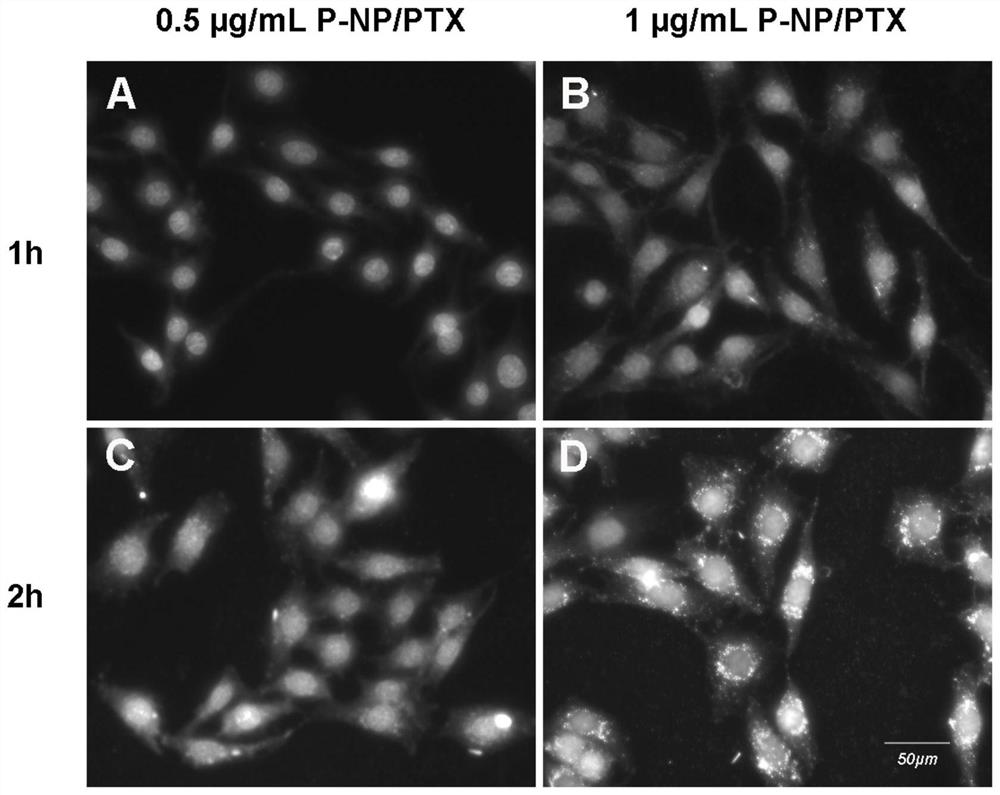An intelligent drug delivery system regulated by neutrophil extracellular traps in tumor microenvironment and preparation method thereof
A neutrophil and tumor microenvironment technology, applied in the field of tumor and its microenvironment targeting and sustained release drug delivery system, can solve the problems of unsatisfactory curative effect and easy drug resistance, and achieve inhibition of proliferation and distant metastasis , Improve the effect of treatment, improve the effect of degradation effect
- Summary
- Abstract
- Description
- Claims
- Application Information
AI Technical Summary
Problems solved by technology
Method used
Image
Examples
Embodiment 1
[0045] After adding copper sulfate and sodium ascorbate to the surface polyethylene glycol azide P-NP / PTX solution, add (Pro)GRKKRRQRRRPQPLGLAGGC-DNaseⅠ polypeptide-protein conjugate solution, protect from light, click reaction under nitrogen protection for 6 hours, The reaction solution was refrigerated and centrifuged at 14,000 rpm, and the unreacted (Pro)GRKKRRQRRRPQPLGLAGGC-DNaseI in the supernatant was discarded. After washing twice with water, mP-NP was obtained. S-DNase / PTX. Example 1: Characterization of physicochemical properties of nanoparticles and mP-NPs used in cell migration experiments S - Synthesis of DNase / PTX nanoparticles
[0046] 1.0 g of dithioglycolic acid was mixed with 15 mL of anhydrous acetic anhydride, and under nitrogen protection, the reaction was stirred at 35 °C for 3 h. After the reaction was complete, acetic acid and excess acetic anhydride were removed by rotary evaporation. The rotary-evaporated product was dissolved in dichloromethane, 1....
Embodiment 2
[0052] Example 2: mP-NPs used in qualitative cellular uptake experiments S - Synthesis of DNase / PTX nanoparticles
[0053] PTX-SS-C 18 The synthetic steps are the same as those in Example 1. Weigh out Coumarin-6 and 5mg PTX-SS-C 18 Dissolve in 0.5mL absolute ethanol. At room temperature, the anhydrous ethanol solution was added dropwise to deionized water with constant stirring. After the dropwise addition was completed, the stirring was continued for 5 min, the ethanol was removed by rotary evaporation, and finally filtered through a 0.22 μm microporous membrane to obtain coumarin-6 labeling PTX prodrug nanoparticles.
[0054] Subsequent steps are the same as in Example 1, and the mP-NP of Coumarin-6 must be marked S - DNase / PTX nanoparticles. The nanoparticles can be taken up by tumor cells, and the amount of uptake is time-dependent and concentration-dependent, such as figure 2 shown.
Embodiment 3
[0055] Example 3: mP-NPs for in vivo pharmacodynamics S - Synthesis of DNase / PTX nanoparticles
[0056] 5.0 g of dithioglycolic acid was mixed with 75 mL of anhydrous acetic anhydride, and under nitrogen protection, the reaction was stirred at 35 °C for 3 h. After the reaction was complete, acetic acid and excess acetic anhydride were removed by rotary evaporation. The rotary-evaporated product was dissolved in dichloromethane, 7.45 g of stearyl alcohol and 325 mg of DMAP were added, and the reaction was stirred at room temperature for 15 h, terminated with 1% HAc, and the organic layer was dried over anhydrous sodium sulfate. The crude product was purified by silica gel column chromatography to obtain the intermediate HOOC-CH 2 -SS-CH 2 -COOC 18 . Put the HOOC-CH 2 -SS-CH 2 -COOC 18 HBTU and HBTU were dissolved in dichloromethane in an ice bath, and N,N-diisopropylethylamine was added dropwise. After 30 min of reaction, 1.0 g of PTX was added, and the reaction was con...
PUM
 Login to View More
Login to View More Abstract
Description
Claims
Application Information
 Login to View More
Login to View More - R&D Engineer
- R&D Manager
- IP Professional
- Industry Leading Data Capabilities
- Powerful AI technology
- Patent DNA Extraction
Browse by: Latest US Patents, China's latest patents, Technical Efficacy Thesaurus, Application Domain, Technology Topic, Popular Technical Reports.
© 2024 PatSnap. All rights reserved.Legal|Privacy policy|Modern Slavery Act Transparency Statement|Sitemap|About US| Contact US: help@patsnap.com










